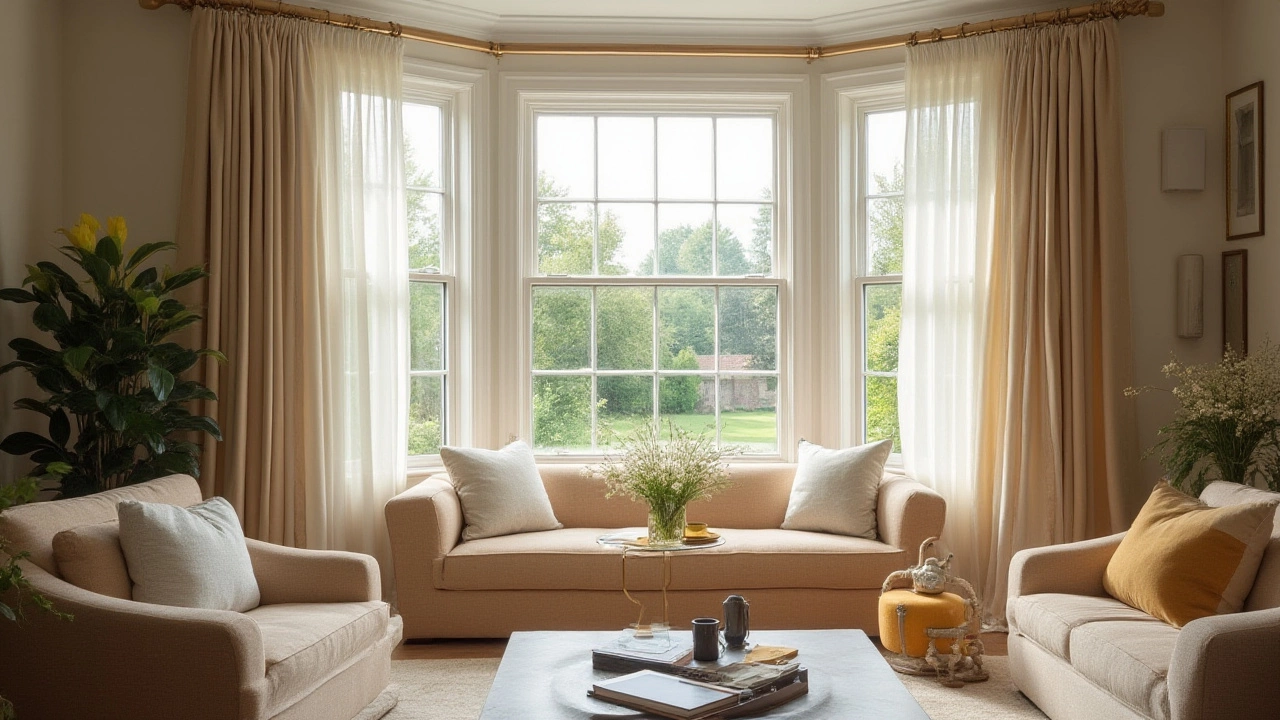Curtain Sizing: How Many Inches Should Curtains Extend Past Your Window?
 Jul, 19 2025
Jul, 19 2025
Ever walked into a room and felt like something was just... off? Odds are, it’s the curtains. People don’t realize how big a deal the right curtain size is. Tiny panels or awkward lengths scream "rushed job" even in a designer living room. Say your window’s 36 inches wide. Should your curtains be the exact same width? Not if you want a look that feels finished, plus all the privacy and light blocking you paid for. Getting the measurements right makes a massive difference—so let’s pull back the curtain (yeah, I went there) and figure out exactly how many inches you should go beyond your window frame.
Why Extending Curtains Matters: Style and Substance
When people think about curtains, they usually focus on patterns or colors. What most folks miss is that the placement—and specifically, how far your curtains extend past your windows—completely changes the feel of the room. Here’s the deal: curtains that extend past the window make the whole window look wider and sometimes taller. This trick works magic for small spaces, low ceilings, or if you just want things to look fancier than they really are.
Let’s talk function for a second, too. Curtains that barely cover a window let in more light around the edges, making blackout options useless and privacy sketchy. Especially at night, when every crack becomes visible, you notice it. And if you ever tried to block out summer heat or winter chills, you know air sneaks right around those edges. Hanging curtains wide and high isn’t just for looks; it actually helps insulation, keeps rooms darker, and saves you money on HVAC bills. A U.S. Department of Energy test from 2022 found that properly sized curtains (meaning at least 4-6 inches past the window on both sides) reduced heat loss by 25% in a typical bedroom. Style meets science.
If you go wide enough, you’ll also protect your curtains from sun damage, because the panels rest on the wall (not in the window) most of the time. This keeps colors brighter, longer. Small detail? Maybe. But buying new curtains every year stings more than measuring an extra few inches.
Matching the curtain extension to your window size is about balance. Think of it like picking out jeans: too short, you look silly, too long, and you’re tripping over the hem. Your window is the same—get those proportions right and the whole room feels intentional.
How Many Inches: The Expert Guidelines
Alright, let’s get down to numbers. Standard advice from interior specialists like Emily Henderson and the folks at Architectural Digest goes like this: Curtains should extend at least 4 to 6 inches past each side of the window frame. But if you want that "custom, dramatic designer" vibe, bump it up to 8, 10, even 12 inches per side. More width means the window looks bigger and your panels can sit off to the side without blocking sunlight.
Here’s an example. Imagine your window is 48 inches wide. For standard coverage (4-6 inches each side), your curtain rod would be 56 to 60 inches. But for that oversized, "wow" look, try 12 inches out: rod length would be 72 inches. This way, when you open your curtains, every inch of glass is exposed—and when you close them, you’ve got total coverage, end to end, without gaps.
curtain sizing also means thinking about length. For most rooms, hang your rod four to six inches above the window frame, or even closer to the ceiling for a taller look. The "high and wide" rule works for almost every space.
Double-check your math before you head to the store. Here’s a quick reference:
| Window Width (inches) | Recommended Rod Width (inches) | Side Extension (inches) |
|---|---|---|
| 24 | 32–36 | 4–6 each side |
| 36 | 44–48 | 4–6 each side |
| 48 | 56–60 | 4–6 each side |
| 60 | 72–76 | 6–8 each side |
| 72 | 88–92 | 8–10 each side |
There are a few exceptions. In crazy small rooms, you might only have space for 2 inches per side. In grand dining rooms, you could stretch to 14 inches if you’ve got the wall for it. If there’s an obstacle (radiator, outlet, another window), work with what you’ve got, but never go to the exact window edge. It just never looks right.

Real-World Scenarios: Adapting the Rules
No room is textbook perfect. Sometimes there’s weird trim, sloped ceilings, light switches, or just… not enough wall. So how do you pull off the "extends past each side" trick if you don’t have much room? It’s about compromise, but not at the expense of style.
When you’re pressed for space, make use of slimmer rods or brackets that mount on the window frame itself, but still let the curtain panel spill over at least a couple of inches. Even a slim two-inch extension on each side beats hugging the glass.
What about bay windows? These don’t play by regular rules. Use adjustable rods that curve, and let each section have at least 4 inches overlap into the wall for privacy. For corner windows, a return rod (which bends to fit the corner) lets you sneak a little extra width, so panels close without gaps.
If you rent and can’t make new holes, there are tension rods or "no drill" brackets that attach with adhesive or pressure. You’re still better off with curtains that extend a bit past the frame, even if you can’t go full luxury-drama width. Safety note: make sure the rod can hold the curtain’s weight—nobody wants a 3 a.m. rod crash.
Here are some quick hacks:
- For blackout or thermal curtains, go wide and high. The more overlap, the better the effect.
- Sheer curtains for privacy? Sizing generously prevents nosy neighbors from peeping through side gaps.
- Short on wall space? Let curtains pool on the floor (“puddle” style). You’ll distract from the width issue by drawing eyes downward.
- To fake bigger windows, pair two rods and layer sheers with heavier panels. Extend both rods past the frame for the best illusion.
- Don’t forget about tiebacks or holdbacks. If you like curtains open most of the time, make sure there’s room to sweep panels out of the way—nothing like sun-starved living rooms to kill the vibe.
One more thing: Check your window’s exposure. East-facing windows might not need the same blackout treatment as a west-facing wall of glass. Prioritize comfort and function, and let the measurement rules fit your daily reality—not the other way around.
Finishing Touches: Curtain Width, Fullness, and Installer Tricks
We’ve talked about length and side extension, so let’s hit the forgotten sibling: width. Most folks just grab two panels that “cover” the window when shut. Big mistake. For real fullness—a look that says luxury rather than cheap motel—the combined width of your curtains should be at least 1.5 to 2.5 times the window’s width (including your extension). That’s right, two or three times wider than the glass itself.
Here’s how it works. If your final rod runs 60 inches (window plus extensions), you want panels totaling 90 to 150 inches wide. Otherwise, you’ll end up with a stretched, wrinkly pancake look instead of those frothy, elegant folds that hide light and sound. Most manufacturers list "panel width," not full spread, so add both sides up before you buy.
For those custom-magazine pleats, professional installers recommend using curtain rings or hooks rather than sliding the panel directly onto the rod. This lets fabric hang straighter and glide open and shut. Another pro tip: iron the curtains, or steam them immediately after you put them up. Even expensive linen looks sad and toy-like straight from the bag.
If you want your curtains to “kiss” the floor or puddle dramatically, measure from the rod to the floor and add an extra 1 to 6 inches. Standard is about 1/2 inch off the floor for easy cleaning. For kids’ rooms or homes with pets, keep things just skimming the surface—less dust, less tripping. If you’re after a hotel look, bump it up and let that fabric pool. There’s no wrong answer as long as it looks intentional and works for your life.
Finally, don’t forget about hardware. Fancy finials, sturdy brackets, and even double rods can give your windows polish for not a lot of extra cash. If you’re investing in custom fabrics, don’t pair them with dollar-store rods—and if you’re on a budget, great rods and perfectly sized panels turn even cheap curtains into something people talk about. Properly hung and extended curtains are the easiest way to go from "meh" to "magazine-ready" in one afternoon. Just remember: when in doubt, go a little higher, a little wider, and always, always double-check your math before you hang a single screw.